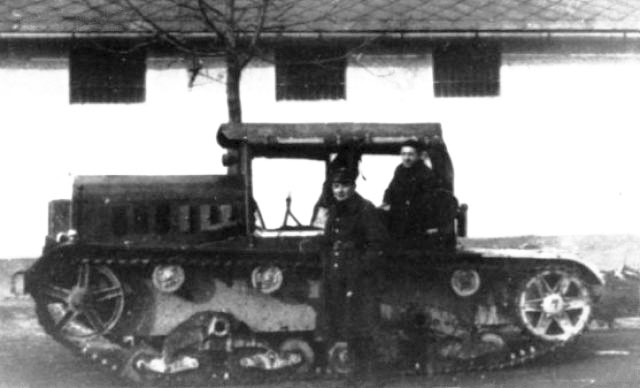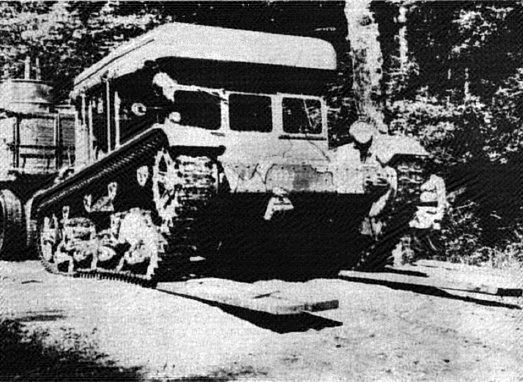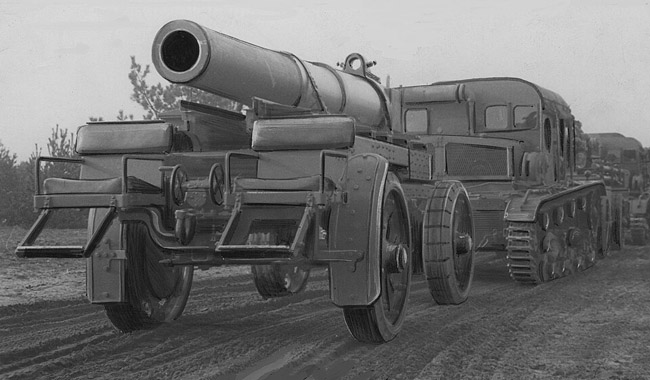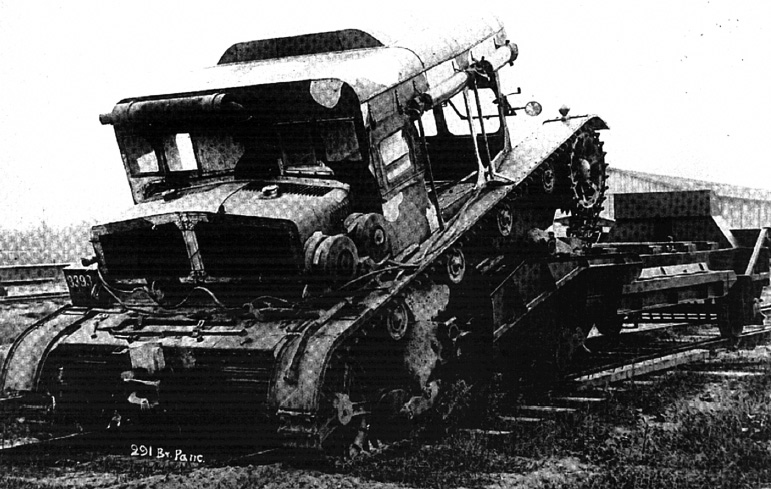C7P (1934)
 Polish Artillery Tracked Tractor, 151 produced (350 ordered 1934)
Polish Artillery Tracked Tractor, 151 produced (350 ordered 1934)
The C7P, standing for "Ciągnik Siedmiotonowy Polski" or "7-tonnes Polish Tractor" was a Polish tracked artillery tractor of the Polish Army which production started in 1934, largely based on the 7TP light tank, itself based on the 1931 Vickers E (6 tons). It was designed in 1931-32 by Witold Jakusz from PZInż and was built at the Ursus factory until September 1939 with a total of 151 delivered or in park, and 108 in active units when the invasion started.
Development
 C6T prototype
C6T prototype
In 1931, Poland purchased from Britain several dozens of British Vickers E tanks with a license for local production. At the time, the Vickers 6-tonnes (Or Vickers E for Export) was considered the best all-around tank of its time. USSR also purchased some, soon massively built locally as the T26. The Polish Army also considered purchasing the Vickers Medium Dragon artillery tractor also based on the Vickers E, but this never happened, perhaps due to steep licencing fees but also because the Vickers E was considered unsuited for the Polish climate and needed adaptation.
It was thus decided to purchase a similar Polish-designed and built vehicle, modified from the Vickers design. Initially code-named VAU-33, this became the design concept for the future 7TP. Work started in parallel on a new artillery tractor for the Polish Army, not only as a substituted to the Dragon tractor, but also to replace the Citroën-Kegresse half-track tractors from France, joined back to the early and mid-1920s. The new artillery tractor was soon called the C6P, with the "6" standing for the tonnage but after modification it was renamed the C7TP. It was praised for its low price, ease of manufacture and durability and overall, great commonality with the 7TP tank. The C7P indeed shared many parts with the 7TP, as both were produced simultaneously from the same suppliers. The chassis was almost identical, and to gaon time, a superstructure was partially borrowed from a license-built Saurer bus, which also provided extra time.
In 1932, plans were ready, and in 1933 the first two prototypes were built at the Ursus factory of PZInż, the C6P and the C6T. The C6P had a front engine with front wheel drive, the C6T had a rear engine and rear wheel drive. Many tests were performed, after which the C6T had its engine moved from the rear to the front, in order to create in early 1934 the C6T/II. The C6P had its engine similarly moved, but to the rear, and its cab was modified, ending wit the new designation C7P/I. The latter was further modified into the C7P/II and C7P/III prototypes. The C6T/II became after many modifications, the C7P/II and defined a standard. production was approved later in 1934 and an order of 350 vehicles named C7P (two variants, internally C7P/II and C7P/III) were produced with minor differences). Production went on until the German and Soviet invasion of September 1939.
 C7P/I prototype
C7P/I prototype
Production & variants: In 1933, two C6P prototypes were delivered (see above). In 1934, a single prototype C7P/III was modified and delivered. In 1934-1936 the bulk of the production (350 were ordered) took place at the Ursus Factory, 73 C7P over two years. No data for 1937 or 1938, but in 1939, 29 C7P were listed in use as artillery towing tractors, plus 13 standard models for armored forces, no unit specified for the remainder of the 108 listed active.
Design
The C7P artillery tractor, as it was designated, was a PZInż design. It used the chassis of the 7TP tank, which was based on the Vickers E tank. The concept of a tractor on this chassis was not new. In Great Britain, already in the late 1920s, along with the development of the Vickers tank, work was carried out on the Dragon Medium Mk IV artillery tractor, which was to pull 60-pound guns. 12 units were produced and transferred to the British army, as well as 23 for China and 18 for India. Similar tractors were created based on the T-26 tank in Russia - these were the T-26T and T-26T2. In May 1931, members of the Polish commission, which was to sign an agreement in England for the purchase of Vickers tanks, became familiar with the British tractor. However, it did not arouse any interest among the Poles.
Work the tractor was carried out in 1933-34, as mentioned earlier in PZInż. It was designed by the head of the Tractor Department of BS PZInż., engineer Witold Jakusz, based on the Vickers E tank purchased in 1931. Although it did not go into serial production, work began on the VAU-33 tank (described in the section on the 7TP tank) and the C6 tracked tractor. The projects were carried out in parallel and both teams supported each other by sharing information and ideas, but work on the C7P progressed faster. The new type of tractors themselves were to replace the worn out Citroen - Kegresse tractors manufactured in France in the early 1920s.

The first C6 prototypes were created in 1933 at PZInż. They were designated C6P and C6T. The C6P prototype had drive wheels in the front, a closed cabin and a winch powered by the tractor engine, while the C6T had drive wheels in the rear and a Saurer truck cabin. Tests with the new vehicle began immediately, covering a distance of about 1,000 km, which resulted in the C6P being selected as the design for further development, especially due to its better parameters for overcoming terrain obstacles. However, the C6T prototype was modified by moving the engine and drive mechanisms from the rear of the hull to the front. The new design was designated C6P/II.
The first C6P prototype was also modified by moving the engine to the rear of the vehicle and rebuilding the cabin. It was given the designation C7P/I, which became the reference model for production. The C7P tractor is often compared to the British tractor and Russian tractors. Our design comes out on top against them, especially due to the built-in cabin, as well as the winch powered by the tractor engine, as well as the headlights and many other aspects. Its additional advantage was its maneuverability in the field and low production costs.
The C7P/I bore the registration number 8393 and was commonly called "Felek". It was sent for field tests in 1934 for sections of 1100 km, during which it covered this route together with the 7TP tank, 2 Vickers tanks with Siddeley engines and several other prototypes. It remained in BBT Br. Panc. as an experimental vehicle until 1939. Based on the C7P/I, the C6P/II prototype was rebuilt to the C7P/II standard. The vehicle became the model for serial production.
Later, a third prototype was created, designated C7P/III. It was built from parts originally intended for the "Słoń" prototype of the 7TP tank in 1934, which meant that the Słoń was not built until 1935. The model vehicle was presented for road tests in August 1934. Field tests were carried out in the Kampinos Forest. Both C7P prototypes were rebuilt several times. Changes included mirrors, reflectors, installations, bogies, and the drive. After the start of production in 1934, the model vehicle took part in another rally from 9 to 18 February 1936, this time on a 985 km route, on the Ursus-Kielce-Krakow-Zakopane-Katowice-Piotrkow-Ursus sections. The C7P/II towed a type R wheeled trailer. Several vehicles took part in this rally, including: C4P tractor and a second C7P with a 220mm mortar from series production. The history of the Second Polish Republic knows several subsequent raids with the participation of the C7P tractor, but it was not possible to establish the dates of all of them.
The Polish tracked tractor had a typical construction layout with the drive at the rear of the hull. Its crew probably consisted of 2 men, but it carried up to 6, so it could carry the gun crew. The driver in the front, right part of the hull. In the rear built-up part there were shelves for 6 backpacks, 6 breadbaskets and 4 rifles. The vehicle had a closed cabin. The vehicles from the first production series can be distinguished by a window in the rear part of the side wall. It was square, and in later series round.
n each side of the hull the running gear consisted of two sets of two bogies with load-bearing wheels, a drive wheel at the front, an idler wheel at the rear of the hull and four rollers supporting the track. In the assembly, one of the bogies was mounted directly to the cast swingarm, the other was connected to it by two flat springs. The swingarm was mounted on a tubular carrier protruding perpendicularly from the hull. Each of the bogies consisted of two supporting wheels covered with a layer of rubber bandage. The rollers, also covered with rubber bandage, were attached directly to the hull, or rather to the armor plates. The track was protected from above by a mudguard.
Drive unit. It consisted of a longitudinally mounted, liquid-cooled, six-cylinder, four-stroke diesel engine with direct injection Sau-TBT-Diesel VBLDb (factory designation PZInż. 235). Its design and capacity of 8.55 cubic liters allowed for 110 HP at 1800 rpm. The obtained power was transmitted by means of a steel-plated articulated shaft to the front part of the hull, where the gearbox with the gear change lever (with four forward and one reverse gear ratios) was located and from where the torque was transmitted to the drive wheels via clutches and gears. The engine's proper operation was ensured, among other things, by two relatively large liquid coolers, located on both sides of the engine. Air circulation was forced by two fans mounted next to the coolers.
The last element of the exhaust system, the muffler, was placed in the upper part of the hull. At the front of the hull were two diesel oil tanks, the main, 110-litre tank on the left side and a 20-litre tank above the gearbox. Additional. It was equipped with a winch powered by the tractor engine. The winch rope could be led out from the front or rear of the tractor, depending on the needs. The automatic towing hitch, designed by PZInż., had an automatic lock. The vehicle also had additional headlights enabling work at night.
specifications |
| Weight | 8.5 t (8.4 long tons; 9.4 short tons) |
| Dimensions | 4.6 x 2.4 x 2.4 (15 ft 1 in x 7 ft 10 in x 7 ft 10 in) |
| Propulsion | PZInż. 235 diesel 115 hp (86 kW) |
| Suspension | Leaf spring bogie |
| Speed (road) | 26 km/h (16 mph) |
| Range | 150 km (93 mi) |
| Armament | None |
| Crew | 6-7 |
| Production | 151 1934-39 |
The C7P in action
 Towing the 220 mm wz 32 mortar in 1939
Towing the 220 mm wz 32 mortar in 1939
In total, only 151 were built before World War II began, approximately 108 deployed to artillery units, as it was used as artillery tractor in regiments using the heaviest artillery, mostly the 220 mm wz.32 Škoda mortar. 18 more of these tractors were attached to various tank units: The 10th Motorized Cavalry Brigade had the bulk of these, for towing any immobilized tank or towing a tanks to the battlefield on specially designed wheeled platforms. Two C7Ps were delivered to the engineering units for road maintenance, destruction of railways in case of war.
During the Invasion of Poland all C7P were in active service and most were captured by the Germans. They were used as towing vehicles and later as snowplows at least until 1942. An additional 52 had been already modified and sent to various communal services indeed as snowplows in 1938-39 to clear the roads in wartime. No C7P survives to this day, but one such hull was recovered near Volgograd on 2001. It was restored with a BT-5 or BT-7 turret to be displayed as a makeshift T-26 tank at the Museum of the Great Patriotic War in Moscow, at Poklonnaya Gora.
The sapper troops were assigned 2 C7Ps, which were used for experimental purposes in the Sappers' BBT. It was planned to equip the C7P with plows, bulldozers and railway bridges. In addition, tests were carried out to tow Polish prototype 155 mm guns and 310 mm mortars, which resulted in the initial determination of equipping the vehicle with a 150 HP engine. Additionally, it was planned to place an order for 52 C7Ps for municipal purposes. Their production was to end in 1942. The Ministry of Communications, which planned to create tank and rail companies, technically securing rail traffic during the war under "Plan W". By 1940, 24 such companies were to be created. The Sappers' Command cooperated with the Ministry of Communication, which selected the C7P for the aforementioned role.
 C7P climbing a railway carriage for deployment in 1939
C7P climbing a railway carriage for deployment in 1939
 C7P towing the 220 mm mortar in 1939
C7P towing the 220 mm mortar in 1939
In the first wave, the series was to consist of 16 vehicles for units and 8 for railway material depots. The arrangements lasted for several months, and the agreement was concluded on August 31, 1938 between the Sappers Command and PZInż (agreement no. 183/38-39) for the delivery of the aforementioned 16 tractors of the first series at a price of PLN 100,000 per unit. The acceptance deadline for 8 units expired on June 30, 1939, and the final deadline for the entire batch was June 30, 1939. On August 8, 1939, the commission of the Ministry of Communication, the SAP Command and the Armored Forces Command began acceptance tests of the second batch of the order. The acceptance was successful and the vehicles were sent to the PKP Signal Workshops in Warsaw, ul. Chmielna. They were intended to service Warsaw, Aleksandrów, Gniezno, Katowice, Kraków, Lviv and Kielce. Peacekeeping service
The C7P tractor was approved for use in the Polish Army on June 12, 1934 by the decision of Brig. Gen. Władysław Langer, who was the deputy of the army administration at that time. It was planned that the vehicle would be assigned to:
Armored units - as an "evacuation tractor" and for transporting tanks on special platforms.
Artillery units - a tractor for the largest caliber guns
Employment units - for felling and towing trees for building bridges, as a tractor for rolling stock and towing light trains (on a rail guide). And for destroying tracks using a special hook.
The most important of these purposes was service in the artillery. Of the 151 units produced, 108 units went to the artillery. It was estimated that the artillery would need 250 machines in the years 1937-42. The tractor was delivered to units in the 19341st Heaviest Artillery Regiment in Góra Kalwaria near Warsaw, where its task was to tow 220 mm wz.32 mortars. The 1st Regiment consisted of the 11th, 12th and 13th heaviest artillery divisions, each with 33 tractors. Each division had 3 batteries with 2 220 mm wz.32 mortars. The battery had 11 C7P tractors. 6 for towing mortars (each in 3 parts), and the rest for the ammunition chain, along with one spare. Several were in the mobilization reserve at the Main Armored Weapons Depot branch. It is known that 18 machines were delivered to the armored forces: 7 in CW Br. Panc in Modlin, 5 in 2nd armored battalion in Żurawica, 4 tractors in 3rd armored battalion. in Warsaw, 2 units in the 4th Armoured Battalion in Brest.
In August, the 12th Armoured Battalion in Lutsk received 4 C7P units from the Main Armoured Depot for the R-35 tank battalion. It was assumed that the 7TP tank battalion would have 3 C7P units on a regular basis, and the R-35 battalion 4 C7P units. It is possible that the 10th BK could have 2 C7P units in the Vickers tank companies. 2 machines were on the regular basis of the sapper troops, for experimental purposes in 1938-39.
 Artillerie Schlepper C7P(p)
Artillerie Schlepper C7P(p)
September 1939: It is difficult to assess the service in September, due to the nature of the machine. First of all, it is known that all 150 machines took part in the fighting. Large numbers were destroyed and scattered on the roads. The tractors were also in besieged Warsaw and were used there for various engineering purposes, because the 220 mm mortars were stored in one place and there was no need to service them. In general, the fate of the C7P vehicles is not fully known.
The Germans destroyed most of the C7P tractors during the 1939 war. The surviving machines were assigned to second-line units, where they were used as tractors for cleaning battlefields after the war with Poland. In 1940-1941, the machines were used as snowplows in the General Government. Their further fate is unknown. It is possible that some numbers ended up in the occupation forces in Norway, which is very likely if we look at the fate of other Polish equipment. The Germans designated them as "Artillerie Schlepper C7P(p)".
Read More/src
derela.pl/c7p
On battlefield3d.com
On dobroni.pl
wikipedia.org
On ww2db.com
creative commons images
panzer-modell.de